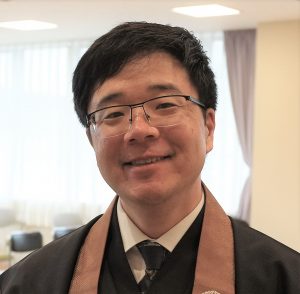
By Rev. Steven Toyoshima
A black hole in outer space, once impossible to see, was just seen by a new telescope. Likewise, the great Buddhist teacher Manshi Kiyozawa tells us: use a telescope to see yourself.
While black holes have appeared in books, movies and television, until recently nobody has seen one. These so-called “collapsed stars” are so massive, their dense gravity traps even light. The strongest telescopes could not take a picture of one.
In April, the Event Horizon Telescope project shocked the world by announcing it captured the first image of a black hole. Although equivalent in size to 6.5 billion suns, spotting it was like trying to find “an orange on the moon,” according to a report, thus requiring more than 200 scientists, seven giant radio telescopes scattered across the world and many years of work.
In Hawaii, where two of the telescopes were located, University of Hawaii professor Larry Kimura named the black hole “Powehi,” a Hawaiian word meaning, “adorned fathomless dark creation.”
In this incredible discovery, I see parallels in how we view ourselves and how we live the Buddhist teachings. In his diary “December Fan,” Kiyozawa wrote about seeing ourselves through microscopes and telescopes.
You should use a microscope to see the good of others and the evil of yourself. You will then be impressed with the great size of their good and your evil.
A telescope should be applied to other’s evil and your good. You will be surprised to see how small they are.
It may indeed be true that both the good and the evil in others and in ourselves are just like things seen through the lenses of the two instruments. Our feelings are apt to distort a real assessment of good and evil, right and wrong, and bring many errors.
The Buddha taught Three Poisons—greed, anger and ignorance—which cloud our judgement in everyday life. It’s difficult to clearly see ourselves, like trying to spot an orange on the moon with the naked eye. Because of our ego, we see our own shortcomings as small, while the shortcomings of others we see as large. I think Kiyozawa was right telling us to use a microscope and telescope to correct our misperceptions.
It’s human nature to think it’s a big deal if another person’s actions inconvenience us, but if we make mistakes, we’ll quickly make excuses and say, “it’s just a tiny thing…why even get upset?” By contrast, how often do we take for granted the helpful actions of others, while getting upset when our “good” deeds go unrecognized? This truly is self-centeredness at work.
Often difficult or unexpected experiences open our eyes to the true world around us sono mama, just as it is. The death of a family member, trouble at work, health issues—many things may break our self-centered view of the world, forcing us to confront true reality. During times of difficulty, we may comprehend the support and love we receive from people around us.
When we understand we are not alone, when we see our connection to others, this is our event horizon telescope array, revealing the reality that was impossible to recognize on our own. It’s this reality that calls to us to be humble and to live with appreciation. To me, this call is the meaning of “Namu Amida Butsu.”
Rev. Toyoshima is a minister at Higashi Hongwanji Mission of Hawaii, Honolulu

